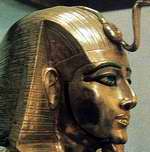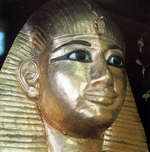| 21st Dynasty (90) 2130-2040BC | |
|
The
Dynasty reigning in the Lower Egypt at Tanis. As it seems this
dynasty was more legitimate than the dynasty of high-priests of Amon
founded by Herhor ruling in the South. Most
reliable dating of the Dynasty as well as the whole III Intermediate
Period seems to be that proposed by Kenneth Kitchen. |
|
|
Smendes |
|
|
It
is difficult to say firmly if Smendes I was king of the Delta yet
during the reign of Ramesses XI or, holding at that time a post of
vizier, proclaimed himself king after Ramesses’ death. Presumably he
was son of Herhor and Nedjemet and became Ramesses XI son-in-law by
marriage with Tentamen. Story of travels of Wenamen mentions Smendes
in context suggesting that he was actual ruler of Egypt. His 26
years long rule, as assigned by Manetho, is also corroborated by
archaeological data, especially “Stele of expelled” ascribed to
Smendes. It is assumed that Smendes ruled for some time over the
whole Egypt until the reign at Thebes was overtaken by high priests
of Amun. Other Datings 1085-1054 (Drioton) |
|
|
Amenemose |
|
|
Presumably
son of Smendes and Tentamon, elder brother of Psusennes I. In
genealogy of priesthood of Memphis he is mentioned before Psusennes
while Manetho, ascribing to him 4 years of rule, placed him after
Psusennes. Most likely at the end of his short reign he made
Psusennes co-regent.
He was about sixty-six years old when he died. Other Datings
1044/43-1040/39 (von Beckerath) |
|
|
Psusennes I |
|
 Son
of Pinedjem I and Henuttaui.
It is possible that for some time he ruled alongside with preceding
him Amenemose as his co-regent. Facts concerning external politics
of this ruler are very santy, possibly he kept trade contacts with
Assiria, as proved by cuneiform inscription in jewellery found in
his tomb. His burial place is a tomb 3, discovered at Tanis in
1939-40 by P. Montet. This tomb, built for Psusennes I, his wife
Mutnedjemet and son of Ramesses – Ankhefenmut, although intact by
tomb robbers, later was used for burial of Amenemipet, Sheshonq
II and chief priest of all gods Wendjebwaendjed. Outer sarcophagus
of Psusennes made of pink granite, belonged primarily to Merenptah.
There was second sarcophagus of black granite enclosed inside it,
holding in turn a coffin of solid silver. P. Montet found many
treasures in this grave, including gold funerary mask, gold and
silver pottery and jewellery. Unfortunately the mummy fell
completely into pieces. Son
of Pinedjem I and Henuttaui.
It is possible that for some time he ruled alongside with preceding
him Amenemose as his co-regent. Facts concerning external politics
of this ruler are very santy, possibly he kept trade contacts with
Assiria, as proved by cuneiform inscription in jewellery found in
his tomb. His burial place is a tomb 3, discovered at Tanis in
1939-40 by P. Montet. This tomb, built for Psusennes I, his wife
Mutnedjemet and son of Ramesses – Ankhefenmut, although intact by
tomb robbers, later was used for burial of Amenemipet, Sheshonq
II and chief priest of all gods Wendjebwaendjed. Outer sarcophagus
of Psusennes made of pink granite, belonged primarily to Merenptah.
There was second sarcophagus of black granite enclosed inside it,
holding in turn a coffin of solid silver. P. Montet found many
treasures in this grave, including gold funerary mask, gold and
silver pottery and jewellery. Unfortunately the mummy fell
completely into pieces.Other Datings 1055-1004
(Redford) |
|
|
Amenophthis |
|
 Son
of Psusennes I and Mutnedjemet, high priest of Amun at Tanis.
Presumably Amenemopet was the father of Osokhor
and Siamon. He helped a prince Hadad of Edom, who took refuge to
Egypt. He was building at Giza (Chapel of Isis) and Memphis (Temple
of Ptah).
Burial place – tomb IV, rather small chamber at the royal necropolis
at Tanis. Subsequently, in times of Siamon his mummy was moved to a
chamber in the tomb of Psusennes I, which was primarily intended for
his mother Mutnedjemet. April 16, 1940 P. Montet discovered the tomb
and found there various pieces gold and silver equipment. Son
of Psusennes I and Mutnedjemet, high priest of Amun at Tanis.
Presumably Amenemopet was the father of Osokhor
and Siamon. He helped a prince Hadad of Edom, who took refuge to
Egypt. He was building at Giza (Chapel of Isis) and Memphis (Temple
of Ptah).
Burial place – tomb IV, rather small chamber at the royal necropolis
at Tanis. Subsequently, in times of Siamon his mummy was moved to a
chamber in the tomb of Psusennes I, which was primarily intended for
his mother Mutnedjemet. April 16, 1940 P. Montet discovered the tomb
and found there various pieces gold and silver equipment.Other Datings 1000-900 (Redford) |
|
|
Osochor |
|
|
Son
of Sheshonq, the “Great chieftain of Libyans Meshwesh” by Mekhtenusekhet.
Manetho ascribes to him six years of rule and a name of Osokhor
which is a Libyan form of Egyptian wsrkn - Osorkon. If
these assumptions were correct, Osokhor should be placed in Libyan
dynasty XXII as Osorkon I and thus numeration of succeeding him
pharaohs of the same name should also be changed. In another opinion
Osokhor was son and successor of Amenemipet and thus should be
ascribed to dynasty XXI. Other Datings 990-984 (Redford) |
|
|
Siamun |
|
|
Origin
of Siamun is not clear. It is believed that he might have been
brother or son of his predecessor Osokhor. Building activities of
Siamun is worth mentioning. He extended temple of Amun at Tanis, at
Memphis he erected temple also in honor of this god. There are also
many in
situ
relics
preserved with name of this king. He made war campaign against
Philistines residing in Palestine and captured city of Gezer became
a dowry of Siamun’s daughter married to Salomon, which certainly
consolidated alliance between Egypt and Israel. Other Datings 984-965 (Redford) |
|
|
Psusennes II |
|
|
Historians
face great problems while trying to identify this ruler. There is
opinion, shared by J. Beckerath, that Psusennes II and Psusennes
III, the high priest of Amun at Thebes, were one and the same
person. It is possible that Psusennes II was local ruler at the
Abydos area and held his rule briefly in times of Sheshonq I,
however in this case the theory of his reign lasting 14 years until
the end of XXI dynasty is out of question. One of Psusennes II
daughters, Tenetsepeh, was wife of Shedsunefertum, the high priest
of Ptah at Memphis. The second one, Maatkare, was married to Osorkon
I. Other Datings 965-931 (Redford) |
|